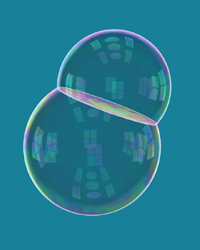DOUBLE BUBBLE CONJECTURE PROVED
March 18, 2000
Four mathematicians have announced a mathematical proof of the Double Bubble Conjecture: that the familiar double soap bubble on the right in Figure 1 is the optimal shape for enclosing and separating two chambers of air. In an address to the Undergraduate Mathematics Conference at the Rose-Hulman Institute of Technology in Indiana on Saturday, March 18, Frank Morgan of Williams College announced that he, Michael Hutchings of Stanford, and Manuel Ritor� and Antonio Ros of Granada had finally proved that the double soap bubble had it right all along.
 |
 |
|---|
The familiar double soap bubble on the right is now known to be the optimal shape for a double chamber. Wild competing bubbles with components wrapped around each other as on the left are shown to be unstable by a novel argument.
Computer graphics by John M. Sullivan, University of Illinois, www.math.uiuc.edu/~jms/Images.
When two round soap bubbles come together, they form a double bubble as on the right in Figure 1. Unless the two bubbles are the same size, the surface between them bows a bit into the larger bubble. The separating surface meets each of the two bubbles at 120 degrees. This precise shape is now known to have less area than any other way to enclose and separate the same two volumes of air, even wild possibilities as on the left in Figure 1, in which the second bubble wraps around the first, and a tiny separate part of the first wraps around the second. Such wild possibilities are shown to be unstable by a new argument which involves rotating different portions of the bubble around a carefully chosen axis at different rates. The breakthrough came while Morgan was visiting Ritor� and Ros at the University of Granada last spring. Their work is supported by the National Science Foundation and the Spanish scientific research foundation DGICYT.
In 1995 the special case of two equal bubbles was heralded as a major breakthrough when proved with the help of a computer by Hass, Hutchings, and Schlafly. The new general case involves more possibilities than computers can now handle. The new proof uses only ideas, pencil, and paper.
In an amazing postscript, a group of undergraduates has extended the theorem to 4-dimensional bubbles. The “SMALL” undergraduate research Geometry Group, consisting of Ben Reichardt of Stanford, Yuan Lai of MIT, and Cory Heilmann and Anita Spielman of Williams, working last summer at Williams under Morgan’s direction, found a way to extend the proof to 4-space and certain cases in 5-space and above. Their work was part of the Research Experiences for Undergraduates sponsored by the National Science Foundation (and Williams College).
The mathematical research announcement is on the web at www.williams.edu/Mathematics/fmorgan/ann.html. A preprint of whole mathematical paper is available at www.ugr.es/~ritore/bubble/bubble.htm.
QUESTIONABLE MATHEMATICS. Dean Thomas recently heard on BBC Radio 5 that the price of oil has risen 300% from 10$ a barrel to 30$ a barrel in the past year. This is, of course, only a 200% increase. Thomas continues, “I did a little experiment this morning at work. I asked people to give the percentage increase from 10 to 12 and then from 10 to 80. Everybody got the first one correct, 20%, but only 3 out of 8 correctly said 700% for the second (most said 800%). It seems that the higher the increase becomes, the more insignificant the original number looks, and people forget to subtract it from the new number. There must be some (fuzzy) point in between 20% and 700% where people mentally make a switch.”
Readers are invited to send in more such examples of questionable mathematics from the media.
OLD CHALLENGE. You can find three equidistant points in the plane (vertices of any equilateral triangle). Likewise, you can find four equidistant points on a round sphere (so that the shortest path on the surface of the sphere between any two of them has the same length). Can you find five or more equidistant points on other surfaces?
ANSWER. For any number n, Joseph DeVincentis describes how to construct a surface with n equidistant points. Put the n points on n little spheres and connect all pairs of spheres by thin, winding tubes. Lengthen the tubes until every pair of points is the same distance apart.
Joe Shipman notes that you can place n equidistant points on a smooth k-holed torus if and only if you can embed the complete graph on n points. Furthermore if you allow nonsmooth surfaces, you can always place n equidistant points. (On a disc, put points evenly around the unit circle; all shortest paths will be length two via the origin, once you put deep, sharp crevices in between.)
Derek Smith notes that there is a very symmetric placement of five equidistant points on the torus, related to the so-called “Shannon capacity” of the pentagon, as beautifully discussed in the recently published Proofs from THE BOOK by Aigner and Ziegler.
NEW CHALLENGE. How should you fence in two adjacent rectangular pens of given areas A1, A2 with the least amount of fencing (including the fencing separating them)?
Send answers, comments, and new questions by email to [email protected], to be eligible for Flatland and other book awards. Winning answers will appear in the next Math Chat. Math Chat appears on the first and third Thursdays of each month. Prof. Morgan’s homepage is at www.williams.edu/Mathematics/fmorgan.
THE MATH CHAT BOOK, including a $1000 Math Chat Book QUEST, questions and answers, and a list of past challenge winners, is now available from the MAA (800-331-1622).
Copyright 2000, Frank Morgan.
 Welcome to my blog. I also have a blog at the
Welcome to my blog. I also have a blog at the